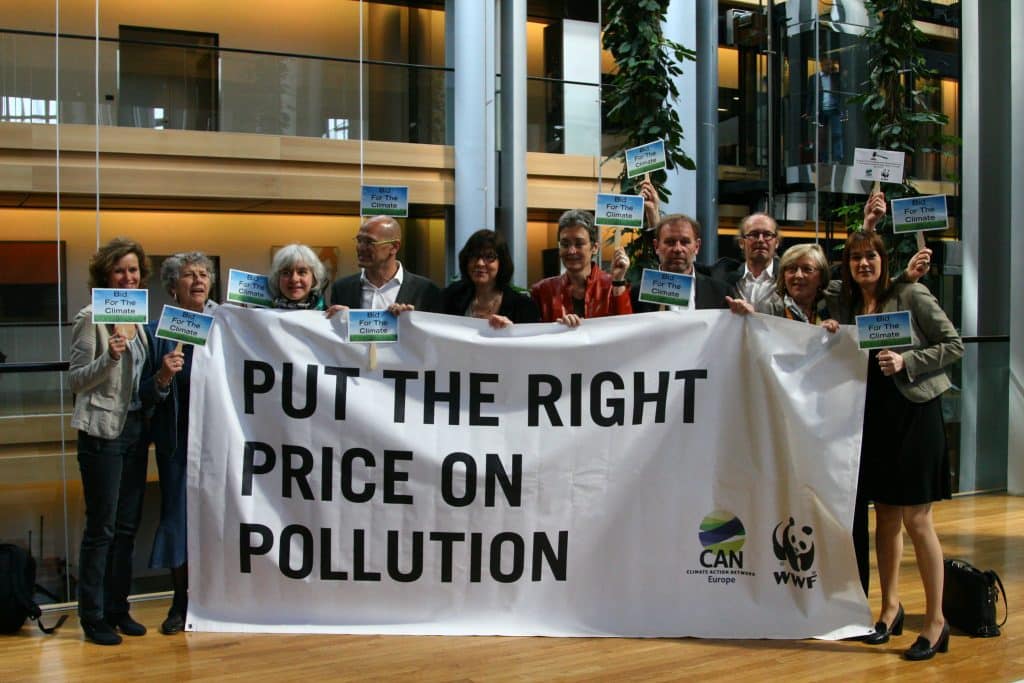Economics and climate change come together in an effort to save the world from rising temperatures and towering waves. Carbon pricing might just be what we need to keep the climate from going off the rails.
—
A product on a store shelf rarely comes with a visible record of its environmental impact for the consumer to see, but that does not mean those impacts and damages don’t exist. Climate change presents a unique economic challenge because greenhouse gas emissions impose costs on society that are not reflected in market prices. This market failure, known as a negative externality, results in excessive emissions and contributes to global warming. Carbon pricing seeks to correct this by assigning a financial cost to emissions, ensuring that businesses and consumers account for the broader social and environmental impact of their activities.
The intersection of economics and climate change policy took a significant leap forward thanks to Economist William Nordhaus, who pioneered the integration of environmental externalities into economic modeling. His research laid the foundation for pricing carbon emissions as a means of internalizing their societal costs, leading to the development of carbon pricing mechanisms.
Since then, carbon pricing has evolved into a crucial global strategy aimed at mitigating greenhouse gas emissions by providing economic incentives for cleaner energy adoption and emissions reduction. In fact, his work from the 1970s onward was so groundbreaking that it earned him the 2018 Nobel Prize for Economics.
The History of Carbon Pricing
Carbon pricing has its roots in economic theory but its implementation as a policy tool has evolved over several decades. The idea of using economic mechanisms to control pollution was first articulated in the 1920s by economist Arthur Pigou, who suggested taxing activities that cause negative externalities. With this framework put forward, the modern application of carbon pricing emerged in the late 20th century, with the work of William Nordhaus and other environmental economists advocating for pricing carbon emissions to reflect their true social costs.
Finland became the first country in the world to introduce a carbon tax in 1990, setting a precedent for market-based climate policies. The tax was initially low but increased over time, influencing other nations to consider similar approaches. Building on the strength of this bold decision, 23 European nations have since implemented carbon taxes, with the tax rates varying based on the social cost of carbon. These range from under €1 (US$1.08) per metric ton of CO2 in Ukraine to more than €100 in Sweden, Liechtenstein, and Switzerland.
While carbon taxation gained early traction in Europe, emissions trading systems (ETS) – another now widely used carbon pricing method – emerged as an alternative mechanism, particularly in the US. The first large-scale cap-and-trade program was the U.S. Acid Rain Program (1990) under the Clean Air Act, which wasn’t a direct jab at carbon dioxide reduction but was instead enforced to successfully reduce sulfur dioxide emissions from power plants. This success laid the groundwork for applying similar principles to carbon dioxide emissions.
The EU ETS, launched in 2005, became the world’s first major, and long standing, carbon market, setting a cap on emissions from power stations and industrial plants. Initially, the trading system was established to primarily cover CO2 emissions but was later expanded to include other gases such as nitrous oxide and perfluorocarbons. The system initially faced challenges, such as an oversupply of allowances that led to price crashes, but subsequent reforms improved its effectiveness, making it a model for other cap-and-trade programs worldwide.
More on the topic: Explainer: What Is a Carbon Tax, Pros and Cons, and Implementation Around the World
The Rationale for Carbon Pricing
Carbon pricing is built on the principle that those who emit carbon dioxide and other greenhouse gases should bear the associated costs. The social cost of carbon is a key metric in this approach, representing the estimated monetary value of damages caused by each additional ton of CO2 emitted. This encompasses impacts such as extreme weather events, rising sea levels, agricultural losses, and public health crises.
By incorporating these costs into economic decision-making, carbon pricing encourages more sustainable behavior and investment in cleaner technologies, incentivizes businesses and individuals to seek cleaner alternatives, and supports governments in using the proceeds to fund climate adaptation projects and infrastructure improvements, and support affected communities.
Carbon pricing is generally implemented through two primary mechanisms: a carbon tax or cap-and-trade.
Carbon Tax
A carbon tax directly sets a price per ton of CO2 emitted. This approach provides price certainty, allowing businesses to plan their investments in emission reduction strategies. While the carbon tax system does not guarantee a specific level of emissions reduction, it has been tested in various parts of the world to help prevent rapid increases in emissions.
British Columbia, Canada, introduced a revenue-neutral carbon tax in 2008, meaning that the revenue generated from the tax was returned to taxpayers through rebates and reductions in other taxes. This approach was designed to maintain fiscal neutrality while encouraging the reduction of carbon emissions. In Sweden, one of the world’s highest carbon taxes was implemented in 1991, initially set at US$26 per ton of CO2 and rising to around $130 per ton over time. This aggressive tax significantly contributed to reducing the country’s reliance on fossil fuels and played a key role in Sweden’s transition to a greener economy. Meanwhile, France introduced a carbon tax starting at €7 in 2014 that rose to €44 by 2018, aiming to curb carbon emissions by making fossil fuels more expensive.
Cap-and-Trade (Emissions Trading System – ETS)
A cap-and-trade system sets a maximum allowable level of emissions (cap) and issues permits or allowances that businesses can buy and sell. This creates a market-driven mechanism for reducing emissions cost-effectively.
The European Union’s ETS, established in 2005, is the world’s largest carbon market, covering a wide range of industries including power generation, steel production, and aviation. The system operates on a cap-and-trade basis, where companies are allocated a certain number of carbon allowances, and those that reduce their emissions below their allowance can sell the surplus.
California’s Cap-and-Trade Program, launched in 2013, forms a central component of the state’s ambitious climate strategy. It is linked with Quebec’s carbon market, creating a broader regional market for emissions reductions. The Regional Greenhouse Gas Initiative (RGGI), which began in 2009, is a cooperative effort among several Northeastern US states to cap and reduce emissions from the power sector. This regional initiative focuses on reducing carbon emissions from electricity generation, setting a regional cap that decreases over time.
Public and Political Resistance
It is common for policies to encounter opposition and hesitation in acceptance but some policies face a stronger pushback than others. Carbon pricing policies, in particular, often face resistance due to concerns about their economic impact, especially on lower-income groups and industries that rely on fossil fuels. End users have never had to be concerned about paying for the environmental damages of the products they use, so when they are asked to pay for it because of price increase due to taxation systems, there exists uncertainty which leads to strong measures.

France’s Yellow Vest protests in 2018 were sparked by a sharp increase in fuel taxes, which disproportionately impacted rural and working-class citizens. The protests were held as a sign of dissatisfaction and anger to convey the economic strain on these groups, leading to widespread unrest and the eventual suspension of the tax. In the years following the protests, the government focused on finding a balance between environmental goals and the economic impact on citizens. Some of the other proposed measures, like carbon taxes and other green initiatives, were adjusted or delayed, but the fuel tax hike itself was never reintroduced at that time. In Australia, the carbon tax introduced in 2012 was repealed in 2014 after significant opposition from industries and conservative politicians, who argued that it imposed an undue economic burden. In Ontario, Canada, political changes in 2018 resulted in the repeal of the province’s cap-and-trade system. This rollback emphasized the critical role that governance and political climate play in the success or failure of carbon pricing policies.
Modern Adoption and Future Trends
Today, carbon pricing is evolving beyond traditional taxation and cap-and-trade systems. The emergence of carbon credit markets allows companies to offset emissions through reforestation, renewable energy projects, and carbon sequestration technologies.
A key region leading carbon pricing initiatives is the European Union, which has strengthened its ETS framework and introduced a border carbon adjustment mechanism to address carbon leakage. In the US, states like Washington, Michigan, and Nevada are exploring carbon pricing mechanisms, signaling growing interest in addressing emissions at the state level.

Several countries around the world have made significant progress in implementing carbon pricing mechanisms. South Korea implemented its national emissions trading system in 2015, becoming the first Asian country to do so. It covers large industrial sectors as part of its broader climate action strategy. New Zealand introduced its ETS in 2008; it covers sectors including forestry, agriculture, and energy, aiming to reduce emissions from multiple sources. In South America, Chile became the first country to introduce a nationwide carbon tax in 2017, targeting large-scale stationary sources like power plants and industrial facilities. Similarly, Mexico implemented a carbon tax in 2014, applying to fossil fuels based on their carbon content, and in 2020, it introduced a pilot emissions trading system for the power and industrial sectors. China launched its national carbon market in 2021, initially focusing on the power sector but with plans to expand to other industries over time. As the world’s largest carbon market by emissions covered, China is playing a key role in global carbon pricing.
Carbon pricing remains one of the most effective tools for reducing emissions, but its success depends on careful policy design, strong political commitment, and public support. There needs to be a unanimous agreement on what this pricing system should look like, both to justify the damage caused by emissions and to avoid causing turmoil to the masses. The diverse experience, or what could also be called trial and error, contributing to the legacy of carbon pricing in different parts of the world shows just how important it is to address economic and social concerns to ensure long-term viability.
As climate change continues to accelerate, carbon pricing will play a crucial role in global efforts to transition to a low-carbon economy. Policymakers must learn from past successes and failures to create resilient and equitable carbon pricing systems that drive sustainable progress.
This story is funded by readers like you
Our non-profit newsroom provides climate coverage free of charge and advertising. Your one-off or monthly donations play a crucial role in supporting our operations, expanding our reach, and maintaining our editorial independence.
About EO | Mission Statement | Impact & Reach | Write for us









